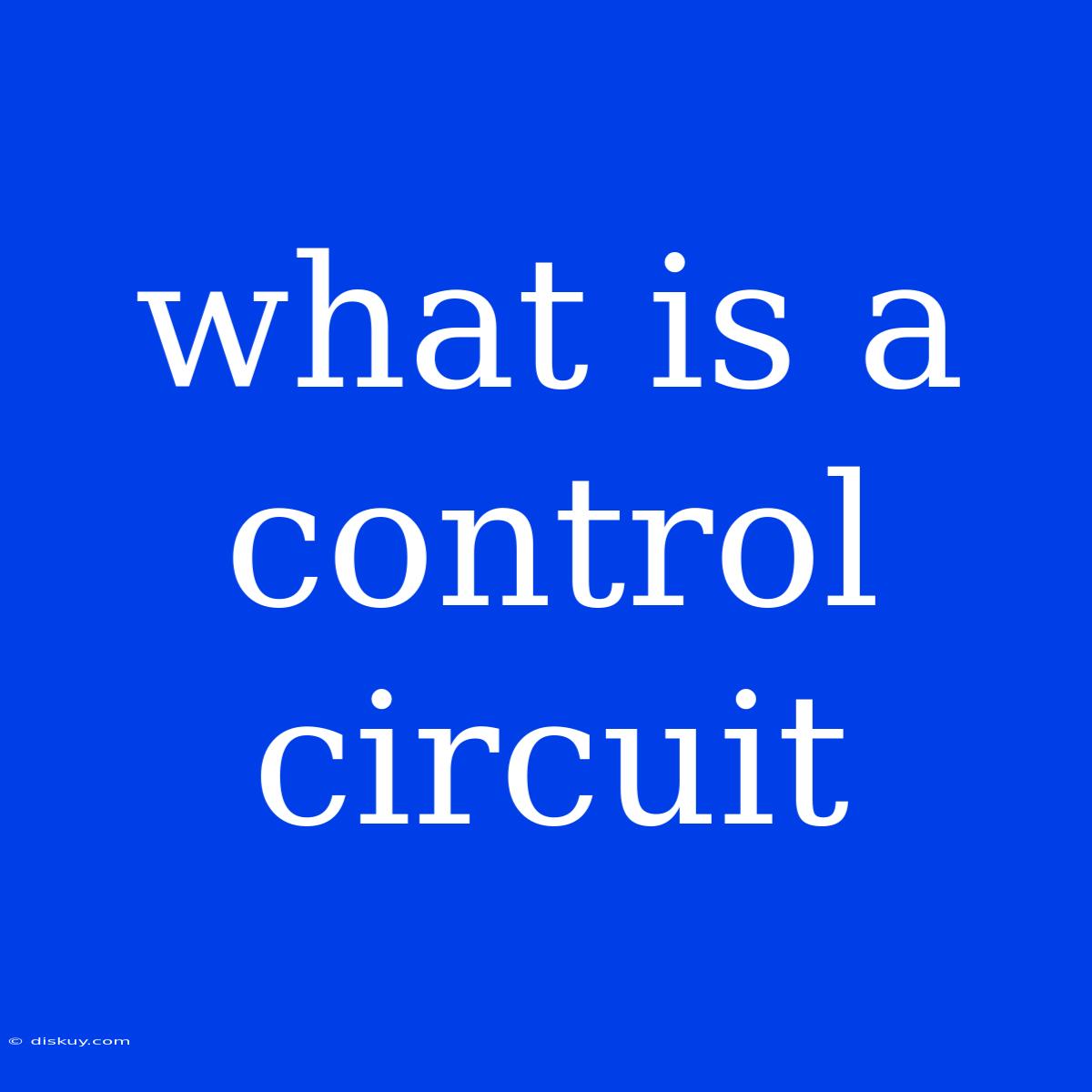What is a Control Circuit: Demystifying the Brains of Electrical Systems
What is a control circuit, and why should you care? Control circuits are the unsung heroes of electrical systems, acting as the "brains" that dictate how and when electricity flows. Understanding these circuits is crucial for anyone working with electrical systems, be it for home repairs, industrial applications, or simply wanting to know how things work.
Editor Note: This article delves into the world of control circuits, providing a comprehensive overview of their function, types, components, and significance. This exploration will equip you with the knowledge to better understand and utilize these vital circuits in various applications.
Control circuits are essential for regulating the flow of electricity in a system. They act as a command center, receiving signals and then manipulating electrical devices based on pre-programmed instructions. Think of them like the nervous system of a machine, relaying information and ensuring smooth operation.
Our analysis of control circuits involved researching various electrical manuals, examining circuit diagrams, and consulting industry experts. This comprehensive approach allows us to present a clear and concise guide for both beginners and those seeking to deepen their understanding.
Key Takeaways of Control Circuits:
| Key Takeaway | Description |
|---|---|
| Function: To control the flow of electricity in a system. | Control circuits regulate the operation of electrical devices by opening and closing circuits based on specific conditions. |
| Components: Typically include sensors, controllers, actuators, and wiring. | Sensors detect changes, controllers process signals, actuators activate devices, and wiring connects the components. |
| Types: Can be analog or digital, simple or complex, and designed for specific tasks. | Diverse types cater to a wide range of applications, from basic lighting control to intricate industrial automation. |
Control Circuit: A Closer Look
Components of a Control Circuit:
Sensors: These are the "eyes and ears" of the control circuit, detecting changes in the environment or system. They convert physical quantities like temperature, pressure, or light into electrical signals.
Controllers: These are the "brains" that receive signals from sensors and make decisions based on pre-programmed instructions. Controllers process data, analyze conditions, and send commands to actuators.
Actuators: These are the "muscles" of the control circuit, performing actions based on commands from the controller. They convert electrical signals into physical actions, such as switching on/off a motor, opening/closing a valve, or controlling a light.
Wiring: This is the "backbone" that connects all the components, providing a pathway for the electrical signals to flow.
Types of Control Circuits:
Analog Control Circuits: These circuits use continuous electrical signals to control devices, often employing variable resistances or voltages. They are well-suited for applications with gradual adjustments, like temperature control.
Digital Control Circuits: These circuits use discrete signals (on/off) to control devices, commonly employing microcontrollers or programmable logic controllers (PLCs). They are ideal for applications with precise and rapid control, like automated machinery.
Significance of Control Circuits:
Control circuits are crucial for optimizing efficiency, safety, and reliability in a vast array of applications. They enable:
- Automation: They automate tasks, increasing productivity and reducing human error.
- Safety: They implement safety measures, protecting equipment and personnel from hazards.
- Precision: They control processes with accuracy and repeatability, ensuring consistent results.
Understanding the Connection between Control Circuits and Electrical Systems
Control circuits are the essential element that links various components within an electrical system, making it function cohesively. By controlling the flow of electricity, they enable complex operations, enhance efficiency, and facilitate precise control.
Further Analysis: Exploring Applications
The widespread use of control circuits spans a wide range of industries, including:
- Industrial Automation: Controlling production lines, robots, and other automated processes.
- Home Appliances: Regulating washing machines, ovens, and other household devices.
- Building Management Systems: Controlling lighting, HVAC, and security systems.
- Automotive Systems: Controlling engine performance, braking, and other vehicular functions.
FAQ:
Q: What is the difference between a power circuit and a control circuit?
A: A power circuit delivers electrical energy to a device, while a control circuit regulates the flow of power to that device.
Q: What is a control system?
**A: ** A control system is a collection of components that work together to regulate and manage a system. A control circuit is a vital part of a control system.
Q: How do I learn more about control circuits?
A: Explore online resources, electrical engineering books, and specialized courses to delve deeper into the intricacies of control circuits.
Tips for Working with Control Circuits:
- Always adhere to safety regulations.
- Understand the components and their functions.
- Carefully analyze circuit diagrams.
- Test circuits thoroughly before operation.
- Consult professionals for complex applications.
Summarizing the Essence of Control Circuits:
This exploration has unveiled the fundamental role of control circuits in electrical systems. They serve as the brains, regulating power flow and enabling precise control. From simple lighting control to intricate industrial automation, control circuits are the driving force behind modern technological advancements.
Closing Message: The insights gained through this journey provide a solid foundation for understanding and utilizing control circuits. As technology continues to evolve, the significance of these circuits will only increase, making this knowledge invaluable for both beginners and seasoned professionals.

